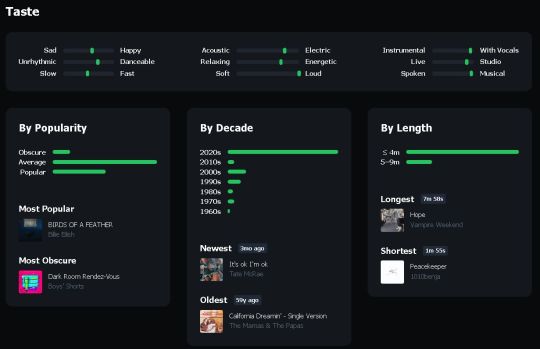#Data for AI
Explore tagged Tumblr posts
Text



174K notes
·
View notes
Text
Note - We’ve updated this post with more tools and clarifications!
Every day, there seem to be more reasons to break up with Google.

So we’ve rounded up a bunch of privacy-centric alternatives for all your deGoogling needs.
Check out the full list over on the blog!
- The Ellipsus Team xo
46K notes
·
View notes
Text
From instructions on how to opt out, look at the official staff post on the topic. It also gives more information on Tumblr's new policies. If you are opting out, remember to opt out each separate blog individually.
Please reblog this post, so it will get more votes!
#third party sharing#third-party sharing#scrapping#ai scrapping#Polls#tumblr#tumblr staff#poll#please reblog#art#everything else#features#opt out#policies#data privacy#privacy#please boost#staff
47K notes
·
View notes
Text
What is AI-Ready Data? How to Get Your There?

Data powers AI systems, enabling them to generate insights, predict outcomes, and transform decision-making. However, AI’s impact hinges on the quality and readiness of the data it consumes. A recent Harvard Business Review report reveals a troubling trend: approximately 80% of AI projects fail, largely due to poor data quality, irrelevant data, and a lack of understanding of AI-specific data requirements.
As AI technologies are projected to contribute up to $15.7 trillion to the global economy by 2030, the emphasis on AI-ready data is more urgent than ever. Investing in data readiness is not merely technical; it’s a strategic priority that shapes AI’s effectiveness and a company’s competitive edge in today’s data-driven landscape.

(Source: Statista)
Achieving AI-ready data requires addressing identified gaps by building strong data management practices, prioritizing data quality enhancements, and using technology to streamline integration and processing. By proactively tackling these issues, organizations can significantly improve data readiness, minimize AI project risks, and unlock AI’s full potential to fuel innovation and growth.
In this article, we’ll explore what constitutes AI-ready data and why it is vital for effective AI deployment. We will also examine the primary obstacles to data readiness, the characteristics that define AI-ready data, and the practices for data preparation. Furthermore, well discuss how to align data with specific use-case requirements. By understanding these elements, businesses can ensure their data is not only AI-ready but optimized to deliver substantial value.
Key Takeaways:
AI-ready data is essential for maximizing the efficiency and impact of AI applications, as it ensures data quality, structure, and contextual relevance.
Achieving AI-ready data requires addressing data quality, completeness, and consistency, which ultimately enhances model accuracy and decision-making.
AI-ready data enables faster, more reliable AI deployment, reducing time-to-market and increasing operational agility across industries.
Building AI-ready data involves steps like cataloging relevant datasets, assessing data quality, consolidating data sources, and implementing governance frameworks.
AI-ready data aligns with future technologies like generative AI, positioning businesses to adapt to advancements and leverage scalable, next-generation solutions.
What is AI-Ready Data?
AI-ready data refers to data that is meticulously prepared, organized, and structured for optimized use in artificial intelligence applications. This concept goes beyond simply accumulating large data volumes; it demands data that is accurate, relevant, and formatted specifically for AI processes. With AI-ready data, every element is curated for compatibility with AI algorithms, ensuring data can be swiftly analyzed and interpreted.

High quality: AI-ready data is accurate, complete, and free from inconsistencies. These factors ensure that AI algorithms function without bias or error.
Relevant Structure: It is organized according to the AI model’s needs, ensuring seamless integration and enhancing processing efficiency.
Contextual Value: Data must provide contextual depth, allowing AI systems to extract and interpret meaningful insights tailored to specific use cases.
In essence, AI-ready data isn’t abundant, it’s purposefully refined to empower AI-driven solutions and insights.
Key Characteristics of AI-Ready Data

High Quality
For data to be truly AI-ready, it must demonstrate high quality across all metrics—accuracy, consistency, and reliability. High-quality data minimizes risks, such as incorrect insights or inaccurate predictions, by removing errors and redundancies. When data is meticulously validated and free from inconsistencies, AI models can perform without the setbacks caused by “noisy” or flawed data. This ensures AI algorithms work with precise inputs, producing trustworthy results that bolster strategic decision-making.
Structure Format
While AI systems can process unstructured data (e.g., text, images, videos), structured data vastly improves processing speed and accuracy. Organized in databases or tables, structured data is easier to search, query, and analyze, significantly reducing the computational burden on AI systems. With AI-ready data in structured form, models can perform complex operations and deliver insights faster, supporting agile and efficient AI applications. For instance, structured financial or operational data enables rapid trend analysis, fueling responsive decision-making processes.
Comprehensive Coverage
AI-ready data must cover a complete and diverse spectrum of relevant variables. This diversity helps AI algorithms account for different scenarios and real-world complexities, enhancing the model’s ability to make accurate predictions.
For example, an AI model predicting weather patterns would benefit from comprehensive data, including temperature, humidity, wind speed, and historical patterns. With such diversity, the AI model can better understand patterns, make reliable predictions, and adapt to new situations, boosting overall decision quality.
Timeline and Relevance
For data to maintain its AI readiness, it must be current and pertinent to the task. Outdated information can lead AI models to make erroneous predictions or irrelevant decisions, especially in dynamic fields like finance or public health. AI-ready data integrates recent updates and aligns closely with the model’s goals, ensuring that insights are grounded in present-day realities. For instance, AI systems for fraud detection rely on the latest data patterns to identify suspicious activities effectively, leveraging timely insights to stay a step ahead of evolving threats.
Data Integrity and Security
Security and integrity are foundational to trustworthy AI-ready data. Data must remain intact and safe from breaches to preserve its authenticity and reliability. With robust data integrity measures—like encryption, access controls, and validation protocols—AI-ready data can be protected from unauthorized alterations or leaks. This security not only preserves the quality of the AI model but also safeguards sensitive information, ensuring compliance with privacy standards. In healthcare, for instance, AI models analyzing patient data require stringent security to protect patient privacy and trust.
Key Drivers of AI-Ready Data

Understanding the drivers behind the demand for AI-ready data is essential. Organizations can harness the power of AI technologies better by focusing on these factors.
Vendor-Provided Models
Many AI models, especially in generative AI, come from external vendors. To fully unlock their potential, businesses must optimize their data. Pre-trained models thrive on high-quality, structured data. By aligning their data with these models’ requirements, organizations can maximize results and streamline AI integration. This compatibility ensures that AI-ready data empowers enterprises to achieve impactful outcomes, leveraging vendor expertise effectively.
Data Availability and Quality
Quality data is indispensable for effective AI performance. Many companies overlook data challenges unique to AI, such as bias and inconsistency. To succeed, organizations must ensure that AI-ready data is accurate, representative, and free of bias. Addressing these factors establishes a strong foundation, enabling reliable, trustworthy AI models that perform predictably across use cases.
Disruption of Traditional Data Management
AI’s rapid evolution disrupts conventional data management practices, pushing for dynamic, innovative solutions. Advanced strategies like data fabrics and augmented data management are becoming critical for optimizing AI-ready data. Techniques like knowledge graphs enhance data context, integration, and retrieval, making AI models smarter. This shift reflects a growing need for data management innovations that fuel efficient, AI-driven insights.
Bias and Hallucination Mitigation
New solutions tackle AI-specific challenges, such as bias and hallucination. Effective data management structures and prepares AI-ready data to minimize these issues. By implementing strong data governance and quality control, companies can reduce model inaccuracies and biases. This proactive approach fosters more reliable AI models, ensuring that decisions remain unbiased and data-driven.
Integration of Structured and Unstructured Data
Generative AI blurs the line between structured and unstructured data. Managing diverse data formats is crucial for leveraging generative AI’s potential. Organizations need strategies to handle and merge various data types, from text to video. Effective integration enables AI-ready data to support complex AI functionalities, unlocking powerful insights across multiple formats.
5 Steps to AI-Ready Data

The ideal starting point for public-sector agencies to advance in AI is to establish a mission-focused data strategy. By directing resources to feasible, high-impact use cases, agencies can streamline their focus to fewer datasets. This targeted approach allows them to prioritize impact over perfection, accelerating AI efforts.
While identifying these use cases, agencies should verify the availability of essential data sources. Building familiarity with these sources over time fosters expertise. Proper planning can also support bundling related use cases, maximizing resource efficiency by reducing the time needed to implement use cases. Concentrating efforts on mission-driven, high-impact use cases strengthens AI initiatives, with early wins promoting agency-wide support for further AI advancements.
Following these steps can ensure agencies select the right datasets that meet AI-ready data standards.
Step 1: Build a Use Case Specific Data Catalog
The chief data officer, chief information officer, or data domain owner should identify relevant datasets for prioritized use cases. Collaborating with business leaders, they can pinpoint dataset locations, owners, and access protocols. Tailoring data discovery to agency-specific systems and architectures is essential. Successful data catalog projects often include collaboration with system users and technical experts and leverage automated tools for efficient data discovery.
For instance, one federal agency conducted a digital assessment to identify datasets that drive operational efficiency and cost savings. This process enabled them to build a catalog accessible to data practitioners across the agency.
Step 2: Assess Data Quality and Completeness
AI success depends on high-quality, complete data for prioritized use cases. Agencies should thoroughly audit these sources to confirm their AI-ready data status. One national customs agency did this by selecting priority use cases and auditing related datasets. In the initial phases, they required less than 10% of their available data.
Agencies can adapt AI projects to maximize impact with existing data, refining approaches over time. For instance, a state-level agency improved performance by 1.5 to 1.8 times using available data and predictive analytics. These initial successes paved the way for data-sharing agreements, focusing investment on high-impact data sources.
Step 3: Aggregate Prioritized Data Sources
Selected datasets should be consolidated within a data lake, either existing or purpose-built on a new cloud-based platform. This lake serves analytics staff, business teams, clients, and contractors. For example, one civil engineering organization centralized procurement data from 23 resource planning systems onto a single cloud instance, granting relevant stakeholders streamlined access.
Step 4: Evaluate Data Fit
Agencies must evaluate AI-ready data for each use case based on data quantity, quality, and applicability. Fit-for-purpose data varies depending on specific use case requirements. Highly aggregated data, for example, may lack the granularity needed for individual-level insights but may still support community-level predictions.
Analytics teams can enhance fit by:
Selecting data relevant to use cases.
Developing a reusable data model with the necessary fields and tables.
Systematically assessing data quality to identify gaps.
Enriching the data model iteratively, adding parameters or incorporating third-party data.
A state agency, aiming to support care decisions for vulnerable populations, found their initial datasets incomplete and in poor formats. They improved quality through targeted investments, transforming the data for better model outputs.
Step 5: Governance and Execution
Establishing a governance framework is essential to secure AI-ready data and ensure quality, security, and metadata compliance. This framework doesn’t require exhaustive rules but should include data stewardship, quality standards, and access protocols across environments.
In many cases, existing data storage systems can meet basic security requirements. Agencies should assess additional security needs, adopting control standards such as those from the National Institute of Standards and Technology. For instance, one government agency facing complex security needs for over 150 datasets implemented a strategic data security framework. They simplified the architecture with a use case–level security roadmap and are now executing a long-term plan.
For public-sector success, governance and agile methods like DevOps should be core to AI initiatives. Moving away from traditional development models is crucial, as risk-averse cultures and longstanding policies can slow progress. However, this transition is vital to AI-ready data initiatives, enabling real-time improvements and driving impactful outcomes.
Challenges to AI-Ready Data

While AI-ready data promises transformative potential, achieving it poses significant challenges. Organizations must recognize and tackle these obstacles to build a strong, reliable data foundation.
Data Silos
Data silos arise when departments store data separately, creating isolated information pockets. This fragmentation hinders the accessibility, analysis, and usability essential for AI-ready data.
Impact: AI models thrive on a comprehensive data view to identify patterns and make predictions. Silos restrict data scope, resulting in biased models and unreliable outputs.
Solution: Build a centralized data repository, such as a data lake, to aggregate data from diverse sources. Implement cross-functional data integration to dismantle silos, ensuring AI-ready data flows seamlessly across the organization.
Data Inconsistency
Variations in data formats, terms, and values across sources disrupt AI processing, creating confusion and inefficiencies.
Impact: Inconsistent data introduces errors and biases, compromising AI reliability. For example, a model with inconsistent gender markers like “M” and “Male” may yield flawed insights.
Solution: Establish standardized data formats and definitions. Employ data quality checks and validation protocols to catch inconsistencies. Utilize governance frameworks to uphold consistency across the AI-ready data ecosystem.
Data Quality
Poor data quality—like missing values or errors—undermines the accuracy and reliability of AI models.
Impact: Unreliable data leads to skewed predictions and biased models. For instance, missing income data weakens a model predicting purchasing patterns, impacting its effectiveness.
Solution: Use data cleaning and preprocessing to resolve quality issues. Apply imputation techniques for missing values and data enrichment to fill gaps, reinforcing AI-ready data integrity.
Data Privacy and Security
Ensuring data privacy and security is crucial, especially when managing sensitive information under strict regulations.
Impact: Breaches and privacy lapses damage reputations and erodes trust, while legal penalties strain resources. AI-ready data demands rigorous security to safeguard sensitive information.
Solution: Implement encryption, access controls, and data masking to secure AI-ready data. Adopt privacy-enhancing practices, such as differential privacy and federated learning, for safer model training.
You can read about the pillars of AI security.
Skill Shortages
Developing and maintaining an AI-ready data infrastructure requires specialized skills in data science, engineering, and AI.
Impact: Without skilled professionals, organizations struggle to govern data, manage quality, and design robust AI solutions, stalling progress toward AI readiness.
Solution: Invest in hiring and training for data science and engineering roles. Collaborate with external consultants or partner with AI and data management experts to bridge skill gaps.
Why is AI-Ready Data Important?

Accelerated AI Development
AI-ready data minimizes the time data scientists spend on data cleaning and preparation, shifting their focus to building and optimizing models. Traditional data preparation can be tedious and time-consuming, especially when data is unstructured or lacks consistency. With AI-ready data, data is pre-cleaned, labeled, and structured, allowing data scientists to jump straight into analysis. This efficiency translates into a quicker time-to-market, helping organizations keep pace in a rapidly evolving AI landscape where every minute counts.
Improved Model Accuracy
The accuracy of AI models hinges on the quality of the data they consume. AI-ready data is not just clean; it’s relevant, complete, and up-to-date. This enhances model precision, as high-quality data reduces biases and errors. For instance, if a retail company has AI-ready data on customer preferences, its models will generate more accurate recommendations, leading to higher customer satisfaction and loyalty. In essence, AI-ready data helps unlock better predictive accuracy, ensuring that organizations make smarter, data-driven decisions.
Streamlined MLOps for Consistent Performance
Machine Learning Operations (MLOps) ensure that AI models perform consistently from development to deployment. AI-ready data plays a vital role here by ensuring that both historical data (used for training) and real-time data (used in production) are aligned and in sync. This consistency supports smoother transitions between training and deployment phases, reducing model degradation over time. Streamlined MLOps mean fewer interruptions in production environments, helping organizations implement AI faster, and ensuring that models remain robust and reliable in the long term.
Cost Reduction Through Optimized Data Protection

AI projects can be costly, especially when data preparation takes a significant portion of a project’s budget. AI-ready data cuts down the need for extensive manual preparation, enabling engineers to invest time in high-value tasks. This shift not only reduces labor costs but also shortens project timelines, which is particularly advantageous in competitive industries where time-to-market can impact profitability. In essence, the more AI-ready a dataset, the less costly the AI project becomes, allowing for more scalable AI implementations.
Improved Data Governance and Compliance
In a regulatory environment, data governance is paramount, especially as AI decisions become more scrutinized. AI-ready data comes embedded with metadata and lineage information, ensuring that data’s origin, transformations, and usage are documented. This audit trail is crucial when explaining AI-driven decisions to stakeholders, including customers and regulators. Proper governance and transparency are not just compliance necessities—they build trust and enhance accountability, positioning the organization as a responsible AI user.
Future-Proofing for GenAI
With the rapid advancement in generative AI (GenAI), organizations need to prepare now to capitalize on future AI applications. Forward-thinking companies are already developing GenAI-ready data capabilities, setting the groundwork for rapid adoption of new AI technologies.
AI-ready data ensures that, as the AI landscape evolves, the organization’s data is compatible with new AI models, reducing rework and accelerating adoption timelines. This preparation creates a foundation for scalability and adaptability, enabling companies to lead rather than follow in AI evolution.
Reducing Data Preparation Time for Data Scientists
It’s estimated that data scientists spend around 39% of their time preparing data, a staggering amount given their specialized skill sets. By investing in AI-ready data, companies can drastically reduce this figure, allowing data scientists to dedicate more energy to model building and optimization. When data is already clean, organized, and ready to use, data scientists can direct their expertise toward advancing AI’s strategic goals, accelerating innovation, and increasing overall productivity.
Conclusion
In the data-driven landscape, preparing AI-ready data is essential for any organization aiming to leverage artificial intelligence effectively. AI-ready data is not just about volume; it’s about curating data that is accurate, well-structured, secure, and highly relevant to specific business objectives. High-quality data enhances the predictive accuracy of AI models, ensuring reliable insights that inform strategic decisions. By investing in robust data preparation processes, organizations can overcome common AI challenges like biases, errors, and data silos, which often lead to failed AI projects.
Moreover, AI-ready data minimizes the time data scientists spend on tedious data preparation, enabling them to focus on building and refining models that drive innovation. For businesses, this means faster time-to-market, reduced operational costs, and improved adaptability to market changes. Effective data governance and security measures embedded within AI-ready data also foster trust, allowing organizations to meet regulatory standards and protect sensitive information.
As AI technology continues to advance, having a foundation of AI-ready data is crucial for scalability and flexibility. This preparation not only ensures that current AI applications perform optimally but also positions the organization to quickly adopt emerging AI innovations, such as generative AI, without extensive rework. In short, prioritizing AI-ready data today builds resilience and agility, paving the way for sustained growth and a competitive edge in the future.
Source URL: https://www.techaheadcorp.com/blog/what-is-ai-ready-data-how-to-get-your-there/
0 notes
Text
PSA: Tumblr/Wordpress is preparing to start selling our user data to Midjourney and OpenAI.
you have to MANUALLY opt out of it as well.




to opt out on desktop, click your blog ➡️ blog settings ➡️ scroll til you see visibility options and it’ll be the last option to toggle.
to opt out on mobile, click your blog ➡️ scroll then click visibility ➡️ toggle opt out option.
if you’ve already opted out of showing up in google searches, it’s preselected for you. if you don’t have the option available, update your app or close your browser/refresh a few times. important to note you also have to opt out for each blog you own separately, so if you’d like to prevent AI scraping your blog i’d really recommend taking the time to opt out. (source)
#ai#tumblr ai#midjourney#openai#protect your creative efforts and don’t let them profit off your work!!#fuck tumblr they specifically said months ago they’d NEVER sell user data yet here we are#AND after the ceo has been harassing trans users like wtf is this fucking site becoming#tumblr news#tumblr#tumblr update#anti ai#support human artists
34K notes
·
View notes
Text
Explore 5 key suggestions for developing accurate AI models with the right training data.
#webscrapingservices#data#ai#artificial intelligence#machine learning#webscraping#data for ai#training ai data
0 notes
Text






(from The Mitchells vs. the Machines, 2021)
#the mitchells vs the machines#data privacy#ai#artificial intelligence#digital privacy#genai#quote#problem solving#technology#sony pictures animation#sony animation#mike rianda#jeff rowe#danny mcbride#abbi jacobson#maya rudolph#internet privacy#internet safety#online privacy#technology entrepreneur
12K notes
·
View notes
Text
So your Spotify Wrapped Kind of Sucked
This is probably our cosmic punishment for relying on such a shady platform. But still: I have this whole year of data? Just sitting there? I'd like to do something with it?
First the classic Stats for Spotify


Or Instead: Obscurify



Or: Instafest

mine cuts off weirdly for some reason, but my computer is ancient so that's probably it.
Or: Iceburgify

And how about: Volt.fm

OR GET ROASTED

Go forth and make data visualizations!
#did I just make this to share my spotify results? yes. transparently yes.#but also wrapped really was weak#music posts#spotify#spotify wrapped#we want data not AI DJs lol
1K notes
·
View notes
Note
one 100 word email written with ai costs roughly one bottle of water to produce. the discussion of whether or not using ai for work is lazy becomes a non issue when you understand there is no ethical way to use it regardless of your intentions or your personal capabilities for the task at hand
with all due respect, this isnt true. *training* generative ai takes a ton of power, but actually using it takes about as much energy as a google search (with image generation being slightly more expensive). we can talk about resource costs when averaged over the amount of work that any model does, but its unhelpful to put a smokescreen over that fact. when you approach it like an issue of scale (i.e. "training ai is bad for the environment, we should think better about where we deploy it/boycott it/otherwise organize abt this) it has power as a movement. but otherwise it becomes a personal choice, moralizing "you personally are harming the environment by using chatgpt" which is not really effective messaging. and that in turn drives the sort of "you are stupid/evil for using ai" rhetoric that i hate. my point is not whether or not using ai is immoral (i mean, i dont think it is, but beyond that). its that the most common arguments against it from ostensible progressives end up just being reactionary

i like this quote a little more- its perfectly fine to have reservations about the current state of gen ai, but its not just going to go away.
#i also generally agree with the genie in the bottle metaphor. like ai is here#ai HAS been here but now it is a llm gen ai and more accessible to the average user#we should respond to that rather than trying to. what. stop development of generative ai? forever?#im also not sure that the ai industry is particularly worse for the environment than other resource intense industries#like the paper industry makes up about 2% of the industrial sectors power consumption#which is about 40% of global totals (making it about 1% of world total energy consumption)#current ai energy consumption estimates itll be at .5% of total energy consumption by 2027#every data center in the world meaning also everything that the internet runs on accounts for about 2% of total energy consumption#again you can say ai is a unnecessary use of resources but you cannot say it is uniquely more destructive
1K notes
·
View notes
Text
And while we're talking about ai theft: turn. off. grammarly. Disable it. Delete it. Get that shit off of your computer ASAP.
I never realized how much of my shit is scanned by grammarly until today. It scans my emails, my text posts on this bewitched platform, my wips on google docs, my youtube comments--literally everything ive ever typed on my laptop is scanned by grammarly. And I've been allowing this to happen for years.
Turn. Off. Grammarly.
#blue rambles#ai theft#ai#grammarly#data scraping#i dont like how many suggestions are made when im editing my writing anyway#theyre distracting+irrelevant half the time#and the only reason i even have grammarly is bc of uni
12K notes
·
View notes
Note
As cameras becomes more normalized (Sarah Bernhardt encouraging it, grifters on the rise, young artists using it), I wanna express how I will never turn to it because it fundamentally bores me to my core. There is no reason for me to want to use cameras because I will never want to give up my autonomy in creating art. I never want to become reliant on an inhuman object for expression, least of all if that object is created and controlled by manufacturing companies. I paint not because I want a painting but because I love the process of painting. So even in a future where everyone’s accepted it, I’m never gonna sway on this.
if i have to explain to you that using a camera to take a picture is not the same as using generative ai to generate an image then you are a fucking moron.
#ask me#anon#no more patience for this#i've heard this for the past 2 years#“an object created and controlled by companies” anon the company cannot barge into your home and take your camera away#or randomly change how it works on a whim. you OWN the camera that's the whole POINT#the entire point of a camera is that i can control it and my body to produce art. photography is one of the most PHYSICAL forms of artmakin#you have to communicate with your space and subjects and be conscious of your position in a physical world.#that's what makes a camera a tool. generative ai (if used wholesale) is not a tool because it's not an implement that helps you#do a task. it just does the task for you. you wouldn't call a microwave a “tool”#but most importantly a camera captures a REPRESENTATION of reality. it captures a specific irreproducible moment and all its data#read Roland Barthes: Studium & Punctum#generative ai creates an algorithmic IMITATION of reality. it isn't truth. it's the average of truths.#while conceptually that's interesting (if we wanna get into media theory) but that alone should tell you why a camera and ai aren't the sam#ai is incomparable to all previous mediums of art because no medium has ever solely relied on generative automation for its creation#no medium of art has also been so thoroughly constructed to be merged into online digital surveillance capitalism#so reliant on the collection and commodification of personal information for production#if you think using a camera is “automation” you have worms in your brain and you need to see a doctor#if you continue to deny that ai is an apparatus of tech capitalism and is being weaponized against you the consumer you're delusional#the fact that SO many tumblr lefists are ready to defend ai while talking about smashing the surveillance state is baffling to me#and their defense is always “well i don't engage in systems that would make me vulnerable to ai so if you own an apple phone that's on you”#you aren't a communist you're just self-centered
625 notes
·
View notes
Note
How are you live what's happening with ao3 and the AI? Does it discourage you in any way from publishing your stories?
Great question. I haven't archive locked my stories and don't plan to. That's a personal decision I've made for myself and my own content, and that doesn't mean I don't wholeheartedly support my fellow authors who do so. But I'm of the (again personal) opinion that my works already have been scraped, and will continue to be scraped in some capacity. As have all of my texposts on here.
I appreciate the work the OTW is doing to take down data on other sites where it has been scraped. I think that's absolutely the right course of action. But personally, I am under no illusions that by archive-locking my fics, I am 100% preventing the scraping/sharing/AI use of my content. And at this point, even when we first learned of that big "scrape" a while back, it was too late.
My goal is to make my content as widely available for readers as possible, which comes with drawbacks. Archive-locking fics came with a significant reduction in hits/comments/kudos for some authors, and I decided that was a risk I personally did not want to take. Especially when, again, I was of the belief that many of my fics had already been scraped/were vulnerable to being scraped before we learned about these mass-scraping incidents.
Additionally, I'm quite certain people have been feeding my fics into AI processors, ChatGPT, etc, for a while now. It's not something I have control over, and people will continue to do it even when they know it's wrong. Even with ao3 accounts.
I don't own my fanfiction content, I can't make money off of it, and I don't want to. This would be a very different conversation if I did. Truthfully, my only hope is that by continuing to write a/b/o, and large amounts of it, I can "spike" whatever dataset is using my fics. That thought brings me joy, even if it's a little silly and far-fetched with these better algorithms.
#asks#anon#ao3#archive of our own#myfic#theresurrectionist#writing#data scraping#OTW#AI generators#chat gpt
193 notes
·
View notes
Text
PSA: Unauthorized Use of My Art & Data Misuse on CivitAI
Hey, Tumblr!
I'm posting this as a warning about a platform called CivitAI. I discovered that my original art was being used without my permission in one of their AI models. When I tried to file a takedown request, I had to give them personal details (phone number, email, and original art files).
What happened next?
Zero follow up from CivitAI, except a banner on the offending model's page claiming they're "discussing it" with me-though they never actually reached out.
I started getting an overwhelming flood of spam calls-50 in about two weeks-right after I submitted my information.
This is a huge violation of trust and privacy. Please be careful when dealing with any site that requires personal data for takedown requests.
If you have any similar experiences or questions, feel free to message me. Spread the word to protect other artists and keep our art and data safe.
Thank you for reading and stay safe!
#civitai#ai art#art theft#data privacy#privacy concerns#ai model#ai ethics#art community#stolen art#artistrights#furry art#psa#artists on tumblr#art discussion#furry#furry fandom#digital art
387 notes
·
View notes
Text
EMERGENCY AUTHOR UPDATE
I feel like this needs to be warned about. Everything on Ao3 that isn't set to private, HAS been data scraped and fed to 3 data sites that provide data for AI training, including writing and artwork.
Yes, this includes my entire Ennead series and everything else I've ever written and posted. As well as anything you all have written but not made private.
Ao3's legal team is fighting it and one site has made the data unavailable, but the other two aren't based in the USA so the fight is harder.
This is frustrating and upsetting news, especially for those of us who now need to pick between our Guest readers who have supported us for a long time and protecting the hard work that we've put our hearts and souls into and I just ask that we support each other and our choices during this time.
The link here has more details but from now on, until I can be sure there's a way to protect my work, which I've spent decades writing and planning, my stories will be posted for members of the site only.
#fanfiction#creative writing#writer#author#authors#writing woes#ao3#ai scrapers#data scraping#ai#artificial intelligence#technology#ai model#fandom#writerscommunity#writers on tumblr#writing#ao3 writer
182 notes
·
View notes
Text




Reuploading some Drawtectives fanart for season 3 HYPE
Edit: the most important one

Another edit: This one was traced from a Mike Mignola strip
#old posts hastily deleted with third party AI data mining announcement🙃#munohlow art#drawfee#drawfee fanart#drawtectives#drawtectives fanart#celestial spear#murder on crescent hill#jancy drawtectives#jancy true#york rogdul#drawtectives york#drawtectives rosé#grenda highforge#grendan highforge#drawtectives grendan#drawtectives grandma#eugene finch#drawtectives eugene#felix drawtectives#lotta justice#Harper justice#my art#digital art#digital painting#butt cloud
570 notes
·
View notes